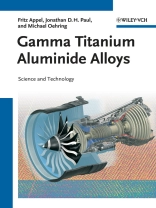The first book entirely dedicated to the topic emphasizes the relation between basic research and actual processing technologies. As such, it covers complex microstructures down to the nanometer scale, structure/property relationships and potential applications in key industries.
From the contents:
* Constitution
* Thermophysical Constants
* Phase Transformations and Microstructures
* Deformation Behaviour
* Strengthening Mechanisms
* Creep
* Fracture Behaviour
* Fatigue
* Oxidation Resistance and Related Issues
* Alloy Design
* Ingot Production and Component Casting
* Powder Metallurgy
* Wrought Processing
* Joining
* Surface Hardening
* Applications and Component Assessment
From the contents:
* Constitution
* Thermophysical Constants
* Phase Transformations and Microstructures
* Deformation Behaviour
* Strengthening Mechanisms
* Creep
* Fracture Behaviour
* Fatigue
* Oxidation Resistance and Related Issues
* Alloy Design
* Ingot Production and Component Casting
* Powder Metallurgy
* Wrought Processing
* Joining
* Surface Hardening
* Applications and Component Assessment
Table of Content
PrefaceINTRODUCTION
CONSTITUTION
The Binary Ti-Al Phase Diagram
Ternary and Multicomponent Alloy Systems
THERMOPHYSICAL CONSTANTS
Elastic and Thermal Properties
Point Defects
Diffusion
PHASE TRANSFORMATIONS AND MICROSTRUCTURES
Microstructure Formation on Solidification
Solid State Transformations
DEFORMATION BEHAVIOR OF SINGLE-PHASE ALLOYS
Single-Phase Gamma(Ti Al) Alloys
Deformation Behavior of Single-Phase Alpha2(Ti3Al) Alloys
Beta/B2 Phase Alloys
DEFORMATION BEHAVIOR OF TWO-PHASE ALPHA(Ti3Al) + GAMMA(Ti Al) ALLOYS
Lamellar Microstructures
Deformation Mechanisms, Contrasting Single-Phase and Two-Phase Alloys
Generation of Dislocations and Mechanical Twins
Glide Resistance and Dislocation Mobility
Thermal and Athermal Stresses
STRENGTHENING MECHANISMS
Grain Refinement
Work Hardening
Solution Hardening
Precipitation Hardening
Optimized Nb-Bearing Alloys
DEFORMATION BEHAVIOR OF ALLOYS WITH A MODULATED MICROSTRUCTURE
Modulated Microstructures
Misfitting Interfaces
Mechanical Properties
CREEP
Design Margins and Failure Mechanisms
General Creep Behavior
The Steady-State or Minimum Creep Rate
Effect of Microstructure
Primary Creep
Creep-Induced Degradation of Lamellar Structures
Precipitation Effects Associated with the Alpha2 -> Gamma Phase Transformations
Tertiary Creep
Optimized Alloys, Effect of Alloy Composition and Processing
Creep Properties of Alloys with a Modulated Microstructure
FRACTURE BEHAVIOR
Length Scales in the Fracture of Ti Al Alloys
Cleavage Fracture
Crack-Tip Plasticity
Fracture Toughness, Strength, and Ductility
Fracture Behavior of Modulated Alloys
Requirements for Ductility and Toughness
Assessment of Property Variability
FATIGUE
Definitions
The Stress-Life (S-N) Behavior
HCF
Effects of Temperature and Environment on the Cyclic Crack-Growth Resistance
LCF
Thermomechanical Fatigue and Creep Relaxation
OXIDATION BEHAVIOR AND RELATED ISSUES
Kinetics and Thermodynamics
General Aspects Concerning Oxidation
Summary
ALLOY DESIGN
Effect of Aluminum Content
Important Alloying Elements – General Remarks
Specific Alloy Systems
Summary
INGOT PRODUCTION AND COMPONENT CASTING
Ingot Production
Casting
Summary
POWDER METALLURGY
Prealloyed Powder Technology
Elemental-Powder Technology
Mechanical Alloying
WROUGHT PROCESSING
Flow Behavior under Hot-Working Conditions
Conversions of Microstructure
Workabiliy and Primary Processing
Texture Evolution
Secondary Processing
JOINING
Diffusion Bonding
Brazing and Other Joining Technologies
SURFACE HARDENING
Shot Peening and Roller Burnishing
Residual Stresses, Microhardness, and Surface Roughness
Surface Deformation Due to Shot Peening
Phase Transformation, Recrystallization, and Amorphization
Effect of Shot Peening on Fatigue Strength
Thermal Stability of the Surface Hardening
APPLICATIONS, COMPONENT ASSESSMENT, AND OUTLOOK
Aerospace
Automotive
Outlook
About the author
Fritz Appel has continued to play an active role in Ti Al research since his retirement in 2006 as group leader of physical metallurgy. He obtained his Ph.D. in 1973 and his habilitation in 1987 from the Martin-Luther University in Halle, Germany. He spent six months in Japan on a JSPS fellowship in 1987, joining the GKSS Research Center in Geesthacht in 1990. Dr. Appel received the Tammann Award from the German Society for Materials Science in 1999 and the Charles Hatchett Award in 2002 from the Institute of Materials, London. He has published over 160 papers, given over 80 invited lectures and holds six patents in the field.Jonathan Paul has been a member of the Institute of Materials Research in Geesthacht since 1999. He obtained his Ph.D. from Manchester University in 1990, and after a year of postdoctoral research, moved to the Commissariat à l’Énergie Atomique at Saclay in 1993. Between 1995 and 1997 he worked as a research fellow at GKSS, before being employed at the Defence Evaluation Research Agency (formerly known as the Royal Aircraft Establishment, now re-named Qineti Q) within the Structural Materials Centre in Farnborough. Dr. Paul received the Vanadium Award in 1995 and the Charles Hatchett Award in 2002, both from the Institute of Materials, London. He has co-authored and authored a number of publications and holds four patents.
Michael Oehring works in the physical metallurgy group at the Institute of Materials Research in Geesthacht. He received his Ph.D. in 1988 from the University of Göttingen, Germany, where he remained until 1989, working in the area of field ion microscopy. He then joined the applied physical metallurgy group at GKSS, where he remained until 1993, before transferring to the group headed by Fritz Appel. Dr. Oehring received the Charles Hatchett Award in 2002 from the Institute of Materials, London, and has authored or co-authored over 100 papers as well as five patents.
Language English ● Format EPUB ● Pages 746 ● ISBN 9783527636211 ● File size 31.4 MB ● Publisher Wiley-VCH ● Published 2011 ● Edition 1 ● Downloadable 24 months ● Currency EUR ● ID 2455437 ● Copy protection Adobe DRM
Requires a DRM capable ebook reader












